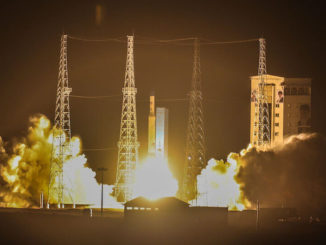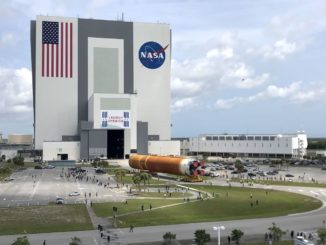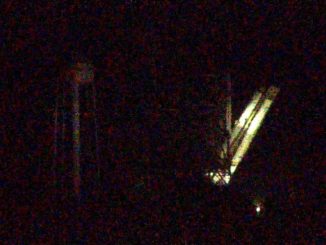
The twin 177-foot-tall (54-meter) solid-fueled boosters for the first flight of NASA’s Space Launch System have been stacked inside the Vehicle Assembly Building at the Kennedy Space Center to await arrival of the rocket’s cryogenic core stage, which is set for a second engine test on a firing stand in Mississippi later this month.
Technicians inside the Vehicle Assembly Building hoisted the nose cone onto the right-hand SLS booster March 2, capping the build-up of the twin solid rockets. Produced by Northrop Grumman, the five-segment boosters are taller, more powerful versions of the solid-fueled rocket motors that flew on space shuttle missions.
Teams at Kennedy began stacking the solid rocket booster segments Nov. 21. The rocket motors are already packed with their solid propellants, and each fully-assembled booster weighs about 1.6 million pounds.
The first Space Launch System test flight, named Artemis 1, will test the heavy-lift rocket and Orion crew capsule that will carry astronauts to the moon. The Artemis 1 mission, which will fly without astronauts, will propel an Orion spacecraft away from Earth to enter a distant orbit around the moon. The test flight will last several weeks before the Orion capsule returns to Earth for splashdown in the Pacific Ocean.
The two solid rocket boosters and four hydrogen-fueled RS-25 engines on the SLS core stage will combine to generate up to 8.8 million pounds of thrust when the rocket blasts off from pad 39B at Kennedy, 15 percent more power than the Apollo-era Saturn 5 moon rocket produced at liftoff. About 80 percent of that thrust will come from the solid-fueled rockets on each side of the SLS core stage.
Ground crews inside the VAB are stacking the first Space Launch System rocket on a mobile platform inside High Bay 3, once used to stack Saturn 5 rockets and space shuttles. The new launch platform, called the Mobile Launcher, was built specifically for the new heavy-lift rocket. Once the SLS is fully assembled, a diesel-powered crawler-transporter — another leftover from the Apollo and space shuttle programs — will carry the platform to pad 39B for launch preparations.
The twin 17-story solid-fueled boosters for the first flight of NASA’s Space Launch System have been fully stacked inside the Vehicle Assembly Building at the Kennedy Space Center to await arrival of the rocket’s core stage.
Read more: https://t.co/w3QQuLpyWt pic.twitter.com/s8eQ8RaH4l
— Spaceflight Now (@SpaceflightNow) March 10, 2021
“Seeing the Space Launch System solid rocket boosters stacked completely on the Mobile Launcher for the first time makes me proud of the entire team, especially the Exploration Ground Systems crew at Kennedy who are assembling them and also the teams at Marshall and Northrop Grumman who designed, tested and built them,” said Bruce Tiller, the SLS boosters manager at NASA’s Marshall Space Flight Center. “This team has created the tallest, most powerful boosters ever built for flight, boosters that will help launch the Artemis 1 mission to the moon.”
The entire Space Launch System will stand about 322 feet (98 meters) tall with the core stage, a cryogenic upper stage, and the Orion capsule and its launch abort tower.
The twin boosters for the Artemis 1 mission will fire more than two minutes during launch, then jettison from the core stage to fall into the Atlantic Ocean.
The rocket motors on the Artemis 1 mission include reusable hardware flown on 40 space shuttle missions. The oldest component first flew on a shuttle launch in 1989.
But NASA will not reuse the solid rocket boosters on the Space Launch System, and the motors won’t carry parachutes for recovery. The RS-25 engines on the core stage are also reused from the space shuttle program, but like then solid rocket boosters, the main engines will be expended on each SLS flight.

The core stage is the final major piece for the Artemis 1 mission not yet delivered to the Kennedy Space Center. The Boeing-built core stage is awaiting a second test-firing of its four RS-25 engines on a test stand at the Stennis Space Center in Mississippi, following an early engine shutdown during a hotfire test in January. NASA officials say the second hotfire test could happen later this month, potentially allowing the core stage to ship from Mississippi to Florida by the end of April.
The SLS upper stage, built by United Launch Alliance, is finished and being readied for stacking at the Florida spaceport. The Lockheed Martin-built Orion spacecraft and its European service module are also done and ready for fueling with propellants for in-space maneuvers.
NASA said teams inside the Vehicle Assembly Building will finish installing electrical instrumentation and pyrotechnics on the SLS boosters prior to the arrival of the core stage, which will be shipped to Florida on NASA’s Pegasus barge and roll into the VAB transfer aisle for inspections and final preparations for stacking. Huge cranes inside the VAB will raise the core stage vertical and lift it into the high bay, then lower the 212-foot-tall (65-meter) rocket between the side-mounted solid boosters.
NASA has not publicly ruled out launching the Artemis 1 mission before the end of this year, but it’s likely the launch won’t happen before early 2022. If the Artemis 1 mission goes according to plan, NASA could launch the Artemis 2 mission, with three NASA astronauts and one Canadian astronaut, on a flight around the moon and back to Earth some time in 2023.
The Artemis program’s goal is to return astronauts to the surface of the moon, and develop a sustainable lunar exploration program including a mini-space station in lunar orbit. The Trump administration wanted astronauts to land on the moon’s south pole on the Artemis 3 mission by the end of 2024, but a lack of funding from Congress has all but eliminated a chance for a human lunar landing in four years.
The Biden administration has signaled its support for the Artemis program, but the White House has not offered a new timetable for a crewed lunar landing.
The Space Launch System had cost $16.4 billion as of last June, according to NASA’s inspector general. The first SLS test launch was originally scheduled for 2017, but the program has faced delays of more than four years. NASA’s inspector general said last month the Artemis program — as laid out by the the Trump administration — will cost nearly $86 billion from fiscal year 2012 through fiscal year 2025.

The joints connecting each piece of Space Launch System’s five-segment rocket motors are certified for one year once booster stacking begins, a clock that began ticking Jan. 7 with the hoisting of the SLS’s left-hand aft center booster segment on top of the booster’s lowermost piece.
But the 12-month certification limit, a holdover from the space shuttle program, could be extended with an engineering review, according to John Honeycutt, NASA’s Space Launch System program manager at the Marshall Space Flight Center in Alabama.
Honeycutt said in January engineers planned to make measurements and collect data as ground teams stacked each segment of the Artemis 1 boosters inside the Vehicle Assembly Building. The data could help NASA and Northrop Grumman extend the certification of the rocket motor joints beyond 12 months.
“That gives us the best opportunity to do some sort of a life extension on the booster stacking in the event that we need that,” Honeycutt said.
Email the author.
Follow Stephen Clark on Twitter: @StephenClark1.



